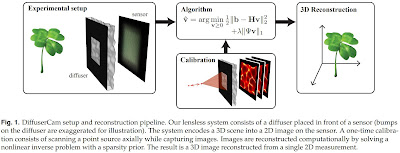UCB researches publish an open-access paper "DiffuserCam: Lensless Single-exposure 3D Imaging" by Nick Antipa, Grace Kuo, Reinhard Heckel, Ben Mildenhall, Emrah Bostan, Ren Ng, and Laura Waller (Ren Ng is Lytro founder). From the abstract:
"We demonstrate a compact and easy-to-build computational camera for single-shot 3D imaging. Our lensless system consists solely of a diffuser placed in front of a standard image sensor. Every point within the volumetric field-of-view projects a unique pseudorandom pattern of caustics on the sensor. By using a physical approximation and simple calibration scheme, we solve the large-scale inverse problem in a computationally efficient way."


The recent IS&T/OSA Small eyes, Smart minds workshop in Wash DC last week featured a day and a half of interesting talks on computational imaging. It was invitation only attendance, limited to 30 people. Hopefully the authors will release their slides and they will be available to all. Speakers included Dave Brady (gigapixel cameras) Rajiv Laroia (Light CTO) (me too). One really interesting talk from Rice Univ. involved lenless imaging for wide FOV large depth of field microscopy using a coded aperture on the sensor (and no lens). The results, after substantial computation, were quite impressive. I wish I could remember their names at the moment, but basically they put the chip right on a mouse brain (ick) to image via fluoroscopy neural activity as the mouse performed some task. You could not use a lens for this application without a relatively giant camera attached to the mouse brain.
ReplyDeleteThe lensless computational imaging thus far does not compete with regular image sensors for image quality for regular 2D imaging and probably never will. But, it can do new things that we cannot easily do with a regular image sensor as described in the UCB paper, and bring new imaging capabilities to bear. With inevitable speedup in computational capability, perhaps even real time video imaging could become viable. We need to pay serious attention to these developments coming mostly from the computer science and optics communities - outside mainstream electronic imaging.
I fully agree. Possibly, one mass market application for lensless imagers is under the display glass fingerprint sensing that Oxi Technology is developing:
Deletehttp://image-sensors-world.blogspot.com/2016/12/synaptics-partners-with-oxi-technology.html
One of the core problem of all these devices is their extreme sensitivity to (mis-)calibration. As they are going away from the information redundancies present in conventional imaging architectures, they become dependent on very high quality alignment/calibration and are rather "fragile" during the acquisition which is a problem in many applications.
DeleteLensless imaging is no problem, as long as the world does not turn into sensorless imaging ...
ReplyDeleteIs it truly lensless if it uses a diffuser? Sure, there's no conventional focusing optics and there's no practical difference between this and a bare-sensor system like PFCA (for examle), but technically the diffuser is functionally equivalent to a lens.
ReplyDelete